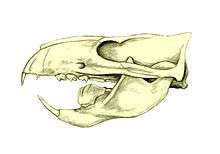Allotheria
| Allotheria Temporal range: Late Jurassic-Miocene, 153–17.5 Ma Range going as far back as the Late Triassic if Haramiyida is part of this | |
|---|---|
 | |
| Skull of Ptilodus | |
| Scientific classification | |
| Kingdom: | Animalia |
| Phylum: | Chordata |
| Clade: | Synapsida |
| Class: | Mammalia |
| Subclass: | Theriiformes |
| Infraclass: | †Allotheria Marsh, 1880 |
| Subgroups | |
| |
Allotheria (meaning "other beasts", from the Greek αλλός, allos-other and θήριον, therion-wild animal) is an extinct branch of successful Mesozoic mammals. The most important characteristic was the presence of lower molariform teeth equipped with two longitudinal rows of cusps.[1] Allotheria includes Multituberculata, Gondwanatheria (which may be part of Multituberculata, as the sister group to Cimolodonta),[2][3][4][5] and probably Haramiyida,[6] though some studies show them to not even be mammals and differing from true allotheres significantly.[7][8]
Allotheres also had a narrow pelvis, indicating that they gave birth to tiny helpless young like marsupials do. This is a feature of all non-placental mammals.[9]
Interpretations
When he first identified Allotheria in 1880, Othniel Marsh regarded this group as an order within Marsupialia. But in 1997, McKenna and Bell classified Allotheria as an infraclass.
References
- ↑ Butler, P.M. (2000). "Review of the early allotherian mammals". Acta Palaeontologica Polonica. 45 (4): 317–342.
- ↑ Krause, D. W.; Prasad, G. V. R.; von Koenigswald, W.; Sahni, A.; Grine, F. E. (1997). "Cosmopolitanism among Gondwanan Late Cretaceous mammals" (PDF). Nature. 390 (6659): 504–507. Bibcode:1997Natur.390..504K. doi:10.1038/37343.
- ↑ Krause, David W.; Hoffmann, Simone; Wible, John R.; Kirk, E. Christopher; Schultz, Julia A.; von Koenigswald, Wighart; Groenke, Joseph R.; Rossie, James B. (2014-11-05). O'Connor, Patrick M., Seiffert, Erik R., Dumont, Elizabeth R., Holloway, Waymon L., Rogers, Raymond R., Rahantarisoa, Lydia J., Kemp, Addison D., Andriamialison, Haingoson. "First cranial remains of a gondwanatherian mammal reveal remarkable mosaicism". Nature. Nature Publishing Group, a division of Macmillan Publishers Limited. online. Bibcode:2014Natur.515..512K. doi:10.1038/nature13922. ISSN 1476-4687.
- ↑ Drake, Nadia (November 5, 2014). "Fossil From Dinosaur Era Reveals Big Mammal With Super Senses". nationalgeographic.com. National Geographic Society. Retrieved November 5, 2014.
- ↑ Wilford, John Noble (November 5, 2014). "Fossil's Unusual Size and Location Offer Clues in Evolution of Mammals". New York Times. Retrieved November 6, 2014.
- ↑ Luo, Z.-X.; Kielan-Jaworowska, Z.; Cifelli, R.L. (2002). "In quest for a phylogeny of Mesozoic mammals". Acta Palaeontologica Polonica. 47 (1): 1–78.
- ↑ Chang, Kenneth (16 November 2015). "Jawbone in Rock May Clear Up a Mammal Family Mystery". New York Times. Retrieved 17 November 2015.
- ↑ Luo, Zhe-Xi; Gates, Stephen M.; Jenkins Jr., Farish A.; Amaral, William W.; Shubin, Neil H. (16 November 2015). "Mandibular and dental characteristics of Late Triassic mammaliaform Haramiyavia and their ramifications for basal mammal evolution". PNAS. doi:10.1073/pnas.1519387112. Retrieved 17 November 2015.
- ↑ Michael L. Power,Jay Schulkin. The Evolution Of The Human Placenta. pp. 68–.
Further reading
Zofia Kielan-Jaworowska, Richard L. Cifelli, and Zhe-Xi Luo, Mammals from the Age of Dinosaurs: Origins, Evolution, and Structure (New York: Columbia University Press, 2004), 249.